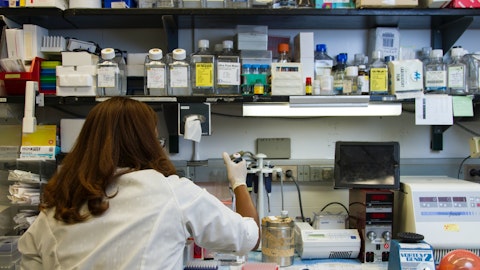Kiniksa Pharmaceuticals, Ltd. (NASDAQ:KNSA) Q4 2023 Earnings Call Transcript February 28, 2024
Kiniksa Pharmaceuticals, Ltd. isn’t one of the 30 most popular stocks among hedge funds at the end of the third quarter (see the details here).
Operator: Good day and thank you for standing by. Welcome to the Kiniksa Pharmaceuticals Fourth Quarter and Full Year 2023 Earnings Conference Call. [Operator Instructions] Please be advised that today’s conference is being recorded. I would now like to hand the conference over to your speaker today, Rachel Frank, Head of Investor Relations. Please go ahead.
Rachel Frank: Thank you, operator. Good morning, everyone and thank you for Kiniksa’s call to discuss our fourth quarter and full year 2023 financial results and recent portfolio execution. A press release highlighting these results can be found on our website under the Investors section. As for the agenda, our Chief Executive Officer, Sanj K. Patel, will start with the introduction. Ross Moat, our Chief Commercial Officer, will provide an update on our ARCALYST commercial execution. John Paolini, our Chief Medical Officer, will review the abiprubart program and recent Phase II data. Then Mark Ragosa, our Chief Financial Officer, will review our fourth quarter and full year 2023 financial results. And finally, Sanj will return for closing remarks and to kick off the Q&A session, for which Eben Tessari, our Chief Operating Officer, will also be on the line.
Before getting started, please note that we will be making forward-looking statements today that are subject to risks and uncertainties that may cause actual results to differ materially from these statements. A review of such statements and risk factors can be found on this slide as well as under the caption Risk Factors contained in our SEC filings. These statements speak only as of the date of this presentation and we undertake no obligation to update such statements, except as required by law. With that, I will turn it over to Sanj.
Sanj Patel: Thanks, Rachel and good morning, everyone. I’ll review our fourth quarter and full year 2023 financial results today. Consistent execution in both commercial and clinical settings throughout 2023 has put us in a strong position to further advance our business in the year ahead. The ARCALYST commercialization continues to see meaningful growth with Q4 net product revenue of $71.2 million, putting us at $233.2 million for the past year. We’re very encouraged with the commercial execution to date which is underscored by growing prescriber adoption and increased duration, as well as continued high patient satisfaction and payer approvals. Moving forward, we remain highly focused on reaching even more patients and driving long-term sustained growth with ARCALYST.
Looking to the year ahead, we have guided to ARCALYST sales of between $360 million to $380 million which would represent roughly 59% year-over-year growth at the midpoint. In terms of our pipeline, we recently provided data from the first 3 cohorts of the abiprubart Phase II rheumatoid arthritis trial. And data from cohort 4, the monthly dosing cohort, are expected in April. Data from this cohort will provide additional dosing insights and are intended to inform future trial design. Based on the data we have evaluated to date, we now expect to advance the asset into a Phase IIb trial in a new indication which will also be announced in April. This next step is already included in our current cash runway guidance. And with that, I’ll turn it over to Ross to review our commercial execution.
Ross?
Ross Moat: Thank you, Sanj. I’m happy to share further details on our fourth quarter and full year 2023 commercial performance, as well as our key priorities for the long-term growth of ARCALYST in recurrent pericarditis. In the fourth quarter, ARCALYST net revenue grew to $71.2 million, representing nearly 80% growth versus Q4 of 2022. This resulted in $233.2 million for the full year 2023 which is a 90% year-on-year growth. This revenue growth was driven by our strategy to increase the awareness of recurrent pericarditis and ARCALYST across the U.S. At the end of 2023, more than 1,700 unique prescribers had written a prescription for ARCALYST since launch, with approximately 24% of those having prescribed for 2 or more patients.
Additionally, we’ve continued to observe robust payer approval rates of greater than 90% for all completed cases. And patient compliance remains greater than 85%, even with the longer durations of therapy that we’re seeing. As of the end of 2023, the average total duration of therapy had increased to approximately 23 months and our focus through education and increasing familiarity with ARCALYST is to continue to better align real-world prescriber practice with the natural history of recurrent pericarditis where the data show patients with 2 or more recurrences suffer with the disease for a median of 3 years. Across the business, we continue to be thoughtful and data-driven with the investments in our commercial infrastructure and we’re focused on prioritizing continued double-digit revenue growth and increasing the collaboration profit year-on-year.
Since launch, we’ve continued to activate an ever-growing prescriber base, with anywhere from between 100 to 250 new first-time prescribers writing an ARCALYST prescription each quarter. As we know, recurrent pericarditis is a rare flaring disease with few high-volume specialty disease centers managing the disease which means most prescribers can go an extended period of time until identifying their next patients. Encouragingly, as time passes since the initial prescription and further patients are identified, we’ve seen a steady growth in prescribers who have written for 2 or more patients. Then as you can see on the right-hand side of this slide, over time, we also see a steady increase in the number who have written for 3, 4 or more patients.
Our focus continues to be on a dual strategy of continuing to grow the total prescriber base while increasing the depth of prescribing. To do this, we’re very focused on targeting where we believe the multiple recurrent patients are, as well as ensuring that both physicians and their patients have a positive experience when initiating ARCALYST and throughout the course of the disease. Additionally, at the end of 2023, greater than 40% of all new prescriptions within the year came from repeat prescribers, demonstrating an increasingly meaningful contribution from this steadily growing group of physicians. We previously announced that as of the end of Q4, approximately 9% of the target population of 14,000 multiple recurrent patients were actively on ARCALYST therapy.

This represents approximately 80% annual growth versus the 5% penetration that we announced as of the end of 2022. This underscores the progress we’ve made since launch as well as the significant opportunity we have in the years ahead to drive much greater growth into the patient population that we can support with ARCALYST. To address the opportunity ahead, our strategy is to accelerate our reach and frequency with the top-tier health care professionals as well as interact with many of the long tail of physicians making up around 11,000 health care professionals in total, who we believe look after the majority of patients suffering from the disease. We’re nearly 3 years post approval of ARCALYST for the treatment of recurrent pericarditis and our commercial execution has been robust, driving net revenue growth every single quarter since launch and provide an increasing collaboration profitability.
Earlier this year, we announced that we expect our continued execution to generate full year 2024 net revenue of between $360 million and $380 million. With that, I’ll hand over to John to discuss abiprubart. John?
John Paolini: Thanks, Ross. As a reminder, the Phase II proof-of-concept trial of abiprubart in rheumatoid arthritis is designed to evaluate the efficacy, dose response, pharmacokinetics and safety of chronic subcutaneous dosing over a duration of 12 weeks. We announced data from the first 3 cohorts of the trial earlier this year and abiprubart showed meaningful clinical effect in each of those cohorts. In cohorts 1 and 2, the PK lead-in, multiple doses of abiprubart were well tolerated and enabled the proof-of-concept portion of the study. Cohort 3 of the trial achieved its primary efficacy endpoint change from baseline in DAS28-CRP versus placebo, with statistical significance in the 5-milligram per kilo weekly dose group.
The 5-milligram per kilo biweekly dose group did not achieve statistical significance, although a higher-than-expected placebo rate was observed. Abiprubart was also well tolerated in this cohort. As we have continued analyzing the data package from the first 3 cohorts, we are confident that abiprubart is a highly active and well-tolerated molecule and has strong potential to reduce autoantibody production, as evidenced by the greater than 40% reduction in rheumatoid factor observed in both cohort 3 dose levels. The Phase II study is continuing with a fourth cohort which advances the dosing regimen from weight-based dosing to fixed milligram dosing using the 400-milligram every 4-week dose level. We did that to achieve plasma concentrations intermediate between the clinically active 2-milligram per kilo biweekly and 5-milligram per kilo biweekly dose groups and which are projected to be in order of magnitude above what is necessary to achieve complete receptor occupancy and TDAR suppression but at a potentially more clinically relevant dosing interval.
Cohort 4 maintains the placebo-controlled efficacy and safety endpoints from cohort 3, with change from baseline in DAS28-CRP at week 12 as the primary efficacy endpoint. As Sanj mentioned, we continue our preparations for further Phase II development and a new indication with abiprubart. And as the data from cohort 4 are added to the totality of the data set informing PK/PD relationships, we plan to finalize future dosing regimens that we will take forward in development. We will have more to say on that in April in conjunction with the cohort 4 data. With that, I will turn it over to Mark to cover our financials. Mark?
Mark Ragosa: Thanks, John. Over the next few minutes, I’ll walk through our fourth quarter and full year 2023 financial performance. You can find our detailed financial information in today’s press release and I’d like to call your attention to a few items. First, total revenue for the fourth quarter was $83.4 million, including ARCALYST net product revenue of $71.2 million, representing nearly 80% growth year-over-year and collaboration revenue of $12.2 million driven primarily by the recognition of a $10 million development milestone for a second new indication under the Genentech license agreement for vixarelimab. Total revenue for the full year 2023 was $270.3 million, including ARCALYST net product revenue of $233.2 million representing approximately 90% year-over-year growth and collaboration revenue of $37.1 million from the Genentech license agreement.
Regarding the $10 million development milestone from Genentech recognized as collaboration revenue in the fourth quarter, the cash was received in January and will be captured in our first quarter 2024 cash balance. To date, we have recognized as collaboration revenue over $124 million of the $125 million earned under the Genentech license agreement and we expect to realize the small remaining balance over the next 2 quarters. Second, ARCALYST collaboration operating profit was $33.9 million in the fourth quarter, representing over 125% growth year-over-year and leading to collaboration expenses of $16.9 million. ARCALYST collaboration operating profit for the full year 2023 was $113 million, representing over 210% year-over-year growth and leading to collaboration expenses of $56.5 million.
Third, higher cost of goods sold and collaboration expenses, both of which are largely driven by ARCALYST revenue growth as well as the advancement of the abiprubart Phase II trial in rheumatoid arthritis and investment related to ARCALYST commercialization drove year-over-year operating expense growth for both the fourth quarter and full year 2023. Fourth, net income for the fourth quarter and full year 2023 was $25.2 million and $14.1 million, respectively, aided by both collaboration revenue as well as the treatment of our noncash deferred tax assets. Lastly, we received $35 million in cash from the Genentech license agreement in 2023. This contributed to net cash flow of approximately $16 million for the year and an ending cash balance of $206.4 million.
We continue to expect these reserves as well as strong ARCALYST commercial execution to fund our current operating plan into at least 2027. With that, I’ll turn the call back to Sanj for closing remarks.
Sanj Patel: Thanks, Mark. As you’ve heard this morning, we expect 2024 to be another exciting year for Kiniksa and our execution in 2023 has put us on the path to continued commercial success and advancing our portfolio in the year ahead. Importantly, we expect our robust commercial performance to meaningfully contribute to our strong financial position and our ability to drive growth across the business. And as Mark said, our current cash position provides runway to fund our operations, including a new indication for abiprubart into at least 2027. Ultimately, we’re determined to continue to provide life-changing medicines for patients and building sustainable value. And we believe we are strategically positioned to do that. We want to thank all of you for your time today and I’ll hand it back to the operator for any questions.
See also 25 US Cities with the Most Breweries Per Capita and 12 Things Retirees Need to Know About Social Security and Taxes.
Q&A Session
Follow Kiniksa Pharmaceuticals Ltd. (NASDAQ:KNSA)
Follow Kiniksa Pharmaceuticals Ltd. (NASDAQ:KNSA)
Operator: [Operator Instructions] Our first question comes from the line of Anupam Rama with JPM.
Anupam Rama: This is Anupam. We talked a lot about repeat prescribers in the opening comments. What are the keys to getting new prescribers at this point given that we’re entering kind of like the third year of launch? Or is this slowly transitioning to more of a repeat prescribers to drive growth?
Ross Moat: Anupam, this is Ross. Thanks very much for the question. Yes and we continue to see good growth in both new prescribers and repeat prescribers as of the end of 2022. And then we’ve got a lot of headroom ahead of us as well. Just to look back a little bit, we ended 2022 with around 800 — or over 800 prescribers and about 22% of those were repeat prescribers. At the end of 2023, we had more than 1,700 prescribers. So obviously, more than doubling throughout the year-on-year and 24% of those as repeat prescribers. So as outlined in the prepared remarks, we’ve seen good steady growth in the repeat prescriber base. But to your question for new prescribers, again, we think we’ve still got a long way to go. With the expansion of our field force and we entered this year with around 85 representatives.
We’re now covering through to around 11,000 doctors. So that’s a significant increase from what we were talking to previously with our slightly smaller field team. So you can even just see from that from 11,000 targeted doctors, we’ve got more than 1,700 total prescribers as of the end of last year. And certainly, not all of those 1,700 are within the target pool as well. So I think from that, that really shows you that there’s still a huge amount of opportunity out there for us which is also, I guess, backed up in the penetration into the target opportunity for the patients that we have on ARCALYST around 9% as well. So pretty excited about the opportunity we’ve got ahead on both the new and repeat prescribers, Anupam.
Operator: And our next question is going to come from the line of Paul Choi with Goldman Sachs.
Paul Choi: Congrats on the strong finish to 2023. My first question is just on how you’re thinking about additional investment here for the commercial business. I know obviously, Ross just mentioned the recently expanded sales force. But maybe just some thoughts on promotional efforts to increase brand awareness, some DTC and/or increasing medical meeting, conference education and things like that? And kind of how you’re thinking about the rate of investment for the business beyond the recent sales force expansion. And then I had a follow-up question on abiprubart.
Ross Moat: Thanks, Paul. This is Ross as well. So maybe I’ll take the first part of that at least. So I think all those things that you mentioned continue to be important to us as they have done the right way through from launch. Even with a larger field team out there now, congress supports, digital marketing, peer-to-peer education, speaker programs, speaker bureau, all those types of initiatives, continue to be very important. And that’s because we know patients are quite widely dispersed across the U.S. as you see from all the numbers that we share. So those opportunities remain and it remains important for us to do that. But we have increased the field team and feel pretty good about that and the number of physicians that we can cover. So I think we’ve been very thoughtful, very data-driven in the build to that field team increase and we continue along the other digital marketing and other types of initiatives as we always have done.
Paul Choi: Okay, great. And then, for a follow-up, for abiprubart. Since you’ve picked a new indication which has yet to be specified. Can you maybe just comment on how the data from cohort 4 might affect your developmental strategy in the Phase IIb strategy beyond dosing frequency? Just anything else that you’re looking for in terms of insight there from cohort 4?
Sanj Patel: Thanks, Paul. This is Sanj. Maybe I’ll start and then John can jump in. I mean I think as you said, we were very encouraged by the data we had from cohorts 1, 2 and 3 which really largely has given us sort of a go signal to move forward with that program in an additional indication. So the data we already have has given us the go. I think cohort 4 will help us, as I said earlier, with the dosing design of the trial. But maybe, John, you could elaborate a little bit on that. So it’s really more of a sort of design implementation as opposed to whether we go or not.
John Paolini: Right. Thank you, Sanj. And Paul, nice to talk to you. So the way that cohort 4 is designed, it’s designed to generate plasma concentrations that sit in between 2 clinically active doses, the 2-milligram per kilo biweekly and the 5-milligram per kilo biweekly. So in that sense, it moves down the bar, if you will, to see if there’s still activity at that concentration which is still roughly an order of magnitude above what is required for full receptor occupancy and TDAR suppression. And so in that sense, it will round out the PK/PD modeling so that then we can choose dosing regimens that we can carry forward into subsequent development gives us a full range of options to choose from.




